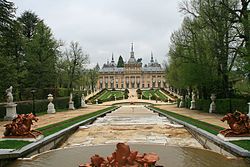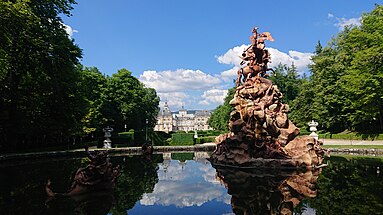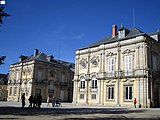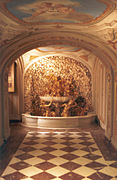Королевский дворец фермы Сан -Ильдефонсо
| Королевский дворец фермы Сан -Ильдефонсо | |
|---|---|
Королевский дворец фермы Сан -Ильдефонсо | |
 | |
 | |
| Общая информация | |
| Архитектурный стиль | Рококо |
| Расположение | Настоящий сайт Сан -Ильдефонсо ( Сеговия ), Испания |
| Строительство началось | 1721 |
| Открыл | Эксклюзивная собственность для монарха: 1724 |
| Управление | Национальное наследие |
| Технические детали | |
| Размер | 25 000 квадратных метров (270 000 кв. Футов) |
| Территория | 146 гектаров (360 акров) садов |
| Дизайн и строительство | |
| Архитектор (ы) | Теодоро Ардеманс |
| Официальное имя | Дворец Сан -Ильдефонсо с его зависимостями и садами |
| Тип | Не мощный |
| Критерии | Памятник |
| Назначен | 11 августа 1925 года |
| Ссылка №. | RI-51-0000314 |
| Официальное имя | Jardines del Palacio de San Ildefonso |
| Type | Non-movable |
| Criteria | Historic Garden |
| Designated | 3 June 1931 |
| Reference no. | RI-52-0000002 |
Королевский дворец La Granja de San Ildefonso (Испанский: Паласио Реал де ла Гранджа де ла Гранджа-де-Сан-Ильдефонсо , зная, как Ла Гранджа , является дворцом начала 18-го века в маленьком городке Сан-Ильдефонсо , расположенным на холмах рядом с Сеговия ) Калмаке (50 миль) к северу от , в провинции Сеговия в центральной части Испании Мадрида
Это стало летней резиденцией Королей Испании с 1720 -х годов во время правления короля Фелипе V. Дворец находится в стиле сдержанного барокко , окруженного обширными садами в формальном стиле Jardin à la Française со скульптурными фонтанами. Теперь он открыт для публики как музей.
История
[ редактировать ]

Район был любимой охотой на многих кастильских королей, из -за его расположения на лесных северных склонах Сьерра -де -Гуадаррама . В 15 -м веке Генрих IV из Кастилии построил первый охотничий домик на площадке вместе с небольшой святыней, посвященной Сан -Ильдефонсо (Сент -Ильдефонс из Толедо), который дал это место свое имя.
Изабелла I из Кастилии предоставила обоим зданиям монахам монахов Санта -Мария -дель -Паррала в Сеговии, которые построили «Альмшаус» и разработали гранджу (ферму) рядом с Лодской и святыней.
Дворец
[ редактировать ]Сайт был приобретен у монахов в 1719 году королем Филиппом V после того, как его летний дворец поблизости в Валсаине сгорел до снаряда. Он был первым испанским королем из французской династии Бурбона . Начиная с 1721 года, Филипп начал строить новый дворец и сады, смоделированные на Версале , построенном его дедушкой, Луи XIV из Франции . Как и Версаль, он охватил курс D'Honneur на приближающейся стороне, и официальные сады, с основной осью, сосредоточенной на дворце, которая была окружена лесами, в которых были утилизированы дополнительные скрытые садовые особенности. Как и Версаль, La Granja начинал как отступление от суда, но стал центром королевского правительства.
Для архитектора Филипп начал с неприхотливого проекта испанского архитектора Теодоро Ардеманса , включающей часовню, сосредоточенную на одном фасаде, которая была расширена на втором этапе, около 1728-34 Фланки, затем дали его окончательный характер Филиппо Джуварра , который был привезен из Турина, основанную на рекомендациях в кругу второй королевы Филиппа, Элизабет Фарнезе из Пармы , [ 1 ] и его помощник, Джованни Баттиста Сакшетти.
When the King decided to abdicate in 1724, his intention was to retire to La Granja. Unfortunately Philip's heir, King Louis I, died that same year, and Philip had to return to the throne. Consequently, a place designed for leisure and quiet retreat thus became an important meeting place for the King, his ministers and the court.[2] The town of San Ildefonso expanded to provide housing and services to the courtiers who wanted a place near the king's favourite residence. Military barracks, a collegiate church (1721–1724, built to designs of Teodoro Ardemans, and dedicated to the Holy Trinity, 22 December 1723), and even a royal glass factory (1728) were built to provide for the palace. The glass factory, which had some initial successes from 1720 at Nuevo Baztan in the province of Madrid, was moved under the direction of its Catalan foreman, Ventura Sit, to San Ildefonso, where supplies of timber were plentiful, and a royal patron was near. The best glass of Venetian type produced in the works dates from the last quarter of the 18th century.[3] Как La Granja de San Ildefonso, The Glassworks продолжается сегодня в качестве дочерней компании Saint Gobain.
The church was selected as his burial site by Philip, marking a break with his Habsburg predecessors. The frescoes by Giambattista Tiepolo, completed by Francisco Bayeu, were badly damaged in a fire of 1918.[4]
Philip's successor Ferdinand VI bequeathed the royal site of San Ildefonso, with all it contained, to his father's second wife, Isabel Farnese, who was effectively forced to live there, well away from Madrid politics, for the duration of his reign. She maintained a considerable court there. At her death in 1766, it reverted to the Crown in the person of her son Charles III.
For the next one hundred and twenty years, La Granja was the court's main summer palace, and many royal weddings and burials, state treaties, and political events took place within its walls. However, from the 1880's the court preferred to sojourn at the seaside palaces in the Basque Country and the royal site became rarely used. In 1918 a major fire damaged the palace and although the damage was repaired much of the interior decoration and contents were lost.
Currently the royal site is part the Patrimonio Nacional of Spain, which holds and maintains many of the Crown's lands and palaces.[5] It is a popular tourist attraction, with gardens, and interiors displaying rooms with marble from Carrara, Japanese lacquer, and crystal chandeliers; portraits and other paintings; and a Museum of Flemish tapestries.[6]

Gardens
[edit]Extending over 1,500 acres (6.1 km2), the gardens around the palace are one of the best examples of 18th-century European garden design in the Jardin à la française style in Spain.[7] The French designer from the official French royal offices of Robert de Cotte was René Carlier,[8] who used the natural slope of the site in the palace grounds design, for enhancing axial visual perspectives, and to provide sufficient head for water to shoot out/up from the twenty-six sculptural fountains in the formal gardens and landscape park.
Sculptors arrived from Paris to execute designs on the site. They included: René Frémin (1672–1744, at La Granja until 1738), to whom the execution of many vases and sculptures was attributed in 18th-century inventories; Jean Thierry; and others who are little more than names in archival references.
Fountains
[edit]All of the fountains represent themes from classical mythology, including Greek deities, allegories and scenes from myths. They are cast in lead to prevent corrosion, and painted over to simulate bronze, a nobler material, or lacquered over white oxidised lead to imitate marble. A group of richly sculptural vases have been attributed to designs by the "dazzling maverick" Gilles-Marie Oppenord,[9] which were probably forwarded through the offices of Robert de Cotte, overseeing French royal building projects as intendant des Bâtiments du Roi. Bruno Pons noted in the sculptural vases "an almost excessively brilliant style, quite distinct from French royal taste and showing an undeniably superior understanding of ornament".[10]
The "Baths of Diana" fountain is the focal point of several garden alleés, and was made from lead and then painted to look like bronze and marble. It and its marble statues form some of the most impressive and well conserved architecture from this period in Spain. Fremin, Thierry, and Bousseau led a team of sculptors who between 1720 and 1745 created this stunning feature, brought to life by the fountains' spectacular water displays. However, regarding the elaborate "Baths of Diana", the chronically depressed Philip remarked, "It has cost me three millions and amused me three minutes."
The original waterworks and piping are still functional. They rely purely on gravity to project water up the fountain jets, including to the 40 metres (130 ft) height of the "Fame" fountain. A reservoir, El Mar (the Sea), lies secluded at the highest point of the landscape park, and provides the supply and water pressure for the whole system. In spite of the protests of the royal accountant, in 1736 twelve dromedaries were sent from the Royal Palace of Aranjuez to help in the works of the reservoir. The last one died in 1740.[11]
In the present day, only a few fountains are active on each day. Twice a year, on the feast days of San Fernando and of San Luis, all twenty-six fountains are set to jet and flow, providing memorable experiences.
Gallery
[edit]-
La Granja facade at Patio de la Herradura.
-
Fountains and Patio de Coches facade.
-
Fountain in the gardens of La Granja.
-
Facade detail.
-
Sphinx on rear terrace at La Granja.
-
El Mar (The Sea)
-
Patio de la Herradura courtyard
-
Print of La Granja palace and gardens in 1873.
-
Royal chapel at La Granja.
-
Fountain and music temple in gardens.
-
Interior of Retreat Room.
-
Funerary Monument of King Philip V and Elizabeth Farnese, by Dumandre & Puthois.
See also
[edit]References
[edit]- ^ His first consort had been Maria Luisa of Savoy from the House of Savoy, the great patrons of Juvarra, but the court style during her lifetime was resolutely French
- ^ Yves Bottineau, L'Art de Cour dans l'Espagne de Philippe V 1700-1746 (Bordeaux, 1965) sets the construction of La Granja in the broader context of court art.
- ^ Frank Gibson, "La Granja Glass" The Burlington Magazine for Connoisseurs 39 No. 225 (December 1921), pp. 304, 308-309.
- ^ Xavier Bray, "The Iconography of Francisco Bayeu's Frescoes for the Colegiata at La Granja de San Ildefonso" The Burlington Magazine 139 No. 1133 (August 1997, pp. 543-547), p. 543; José Manuel de la Mano, "Tiepolo's Commission for the Collegiate Church of the Holy Trinity at La Granja de San Ildefonso" The Burlington Magazine 139 No. 1133 (August 1997), pp. 536-543)
- ^ Patrimonio Nacional: Royal Palace of La Granja de San Ildefonso Archived 2016-01-27 at the Wayback Machine
- ^ Spain.info: La Granja de San Ildefonso Royal Palace
- ^ Patrimonio Nacional: Gardens of the Royal Palace of La Granja de San Ildefonso Archived 2016-01-27 at the Wayback Machine, "History" tab.
- ^ Carlier died in 1722, having laid out the main structural features, it is assumed. Esteban Boutelou continued in his place. The main source for information on the gardens is still Jeanne Digard, Les jardins de la Granja et la sculpture décorative (Paris) 1934.
- ^ Bruno Pons, "Oppenord and the Granja de San Ildefonso" The Burlington Magazine 131 No. 1034 (May 1989), pp. 337-341, based on drawings at the Victoria and Albert Museum and among Robert de Cotte's papers at the Bibliothèque Nationale. The discovery in Spain of an Oppenord sketchbook of iconography opens the possibility that Oppenord travelled to Spain. (Pons 337, note 7)
- ^ Pons 1989:340.
- ^ Gómez-Centurión Jiménez, Carlos (2008). "Exóticos pero útiles: los camellos reales de Aranjuez durante el siglo XVIII" [Exotic but Useful: The Royal Camels of Aranjuez during the 18th Century]. Cuadernos Dieciochistas (in European Spanish) (9): 155–180. ISSN 1576-7914. Retrieved 19 July 2022.
External links
[edit]- Patrimonio Nacional: Royal Palace of La Granja de San Ildefonso website
- Испания IS Culture.com: сады в La Granja de San Ildefonso
- Дворец ферма Сан -Ильдефонсо
40 ° 53´51 ″ с.ш. 4 00 00 Конец с 40 89750 ° С. 4 00444 ° С
Королевский дворец фермы Сан -Ильдефонсо
- Дворцы в Кастилле - Ла Манча
- Сады в Испании
- Исторические дома в Испании в Испании
- Музеи в Кастилле - La Mancha
- Королевские резиденции в Испании
- Сан -Ильдефонсо (Сеговия)
- Дома завершены в 1724 году
- Здания и конструкции в провинции Сеговия
- Барокко дворцы в Испании
- Барокко сады
- Шато с формальными садами во Франции
- 1724 заведения в Испании
- Филиппо Джуварра здания
- Philip V из Испании













